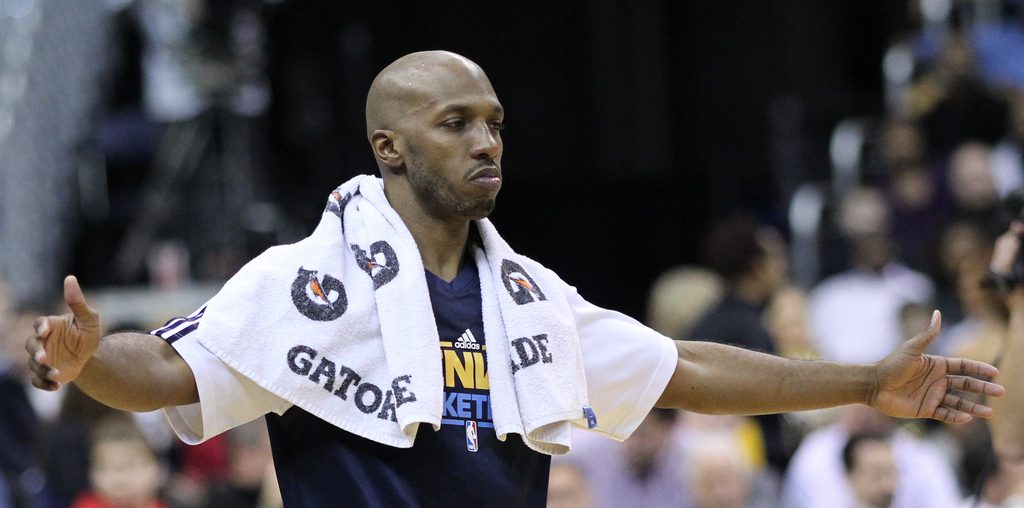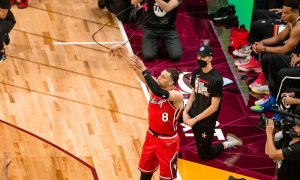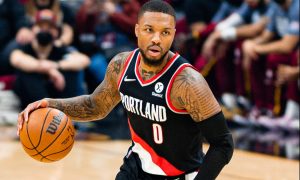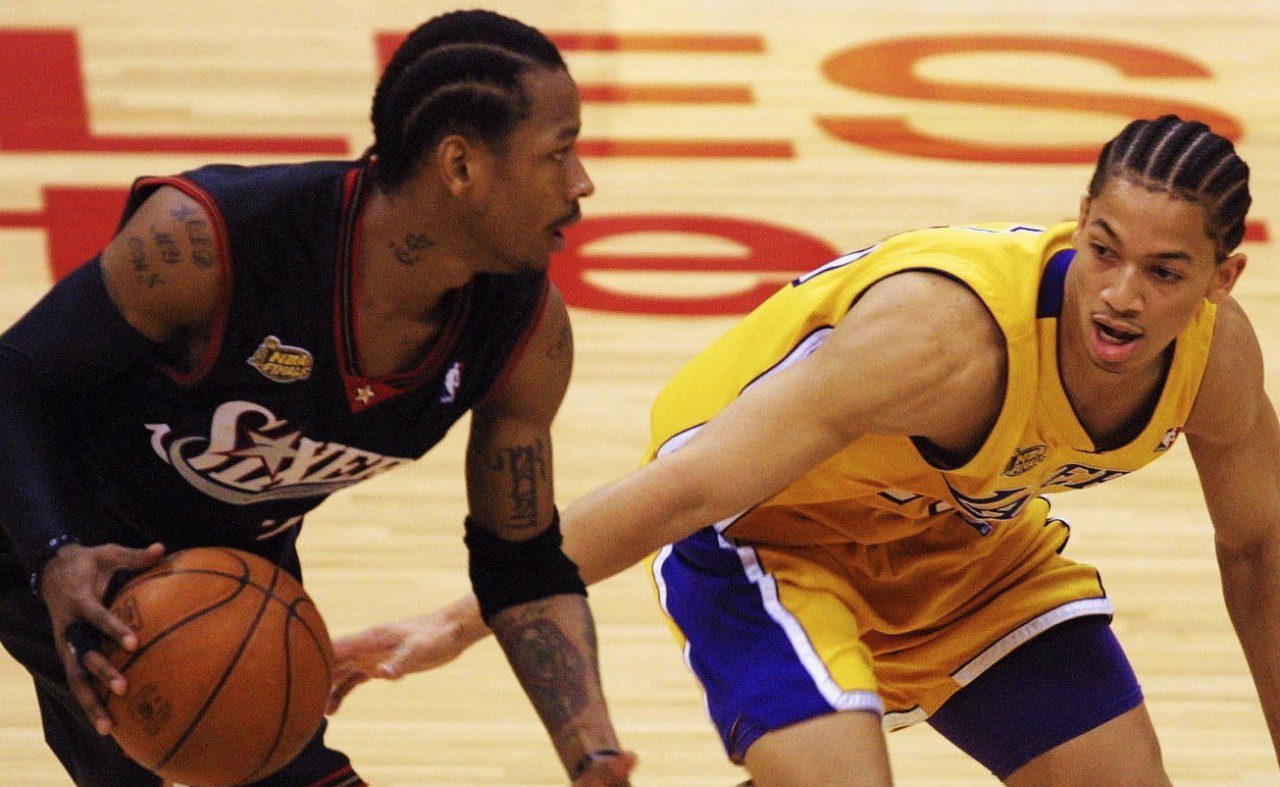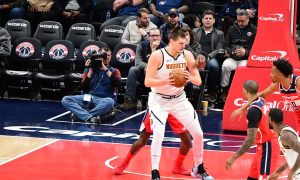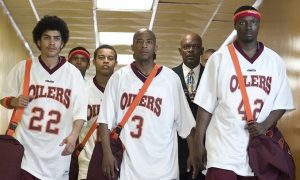Four games. Three referees. Two in-bound passes. And Chauncey Billups.
They love Chauncey Billups in Denver. He is one of their own. The basketball gym at CU (where I went to school) is plastered with giant murals of the man who became known as “Mr. Big Shot” when he also became known as a champion with the Detroit Pistons.
The hometown hero regularly received loud standing ovations before games at the Pepsi Center as a visitor and now he would call the place home. The city was in a frenzy for Billups and a return to what was perceived as a more “team-oriented” style of play. This was, of course, a natural result of taking an excellent isolation player off the team and adding a floor general who was more interested in facilitating others … at least at first.
The Denver Nuggets won four more games in their campaign with Billups than they did the year before with Allen Iverson. That’s it. Four games.
The emergence and health of Nene — who played just 16 games the year before but started 76 in 2008-09 – as well as Carmelo Anthony’s improvement as a defensive player (we will get back to this in great detail later); the “genius” move by the previously lambasted two-headed monster that made up the Nuggets front office at the time to bring in a “leader”; it all amounted to four more wins in the regular season.
Fate, it seems, is not without a sense of irony. –Morpheus
If I’m going to chalk most of Anthony’s early playoff struggles up to bad luck – which I am loudly and proudly doing – then it is only fair to admit that as much as anything else, a primary factor in Anthony finally getting what he called a “gorilla” off his back and moving beyond the first round was an unusual bout with good fortune.
The Western Conference having only five teams with 50 wins that season (as opposed to all eight playoff teams the season before) and those four extra regular season wins meant a first round matchup with the New Orleans Hornets.
Billups was the feel good story and the convenient scapegoat for those who had maligned this team and Carmelo Anthony specifically for years. He provided the perfect “post hoc, ergo propter hoc” opportunity for Anthony’s critics to give credit for the team’s added success to some outside force. And the myth of Mr. Big Shot was born.
A front office that the Denver media had lampooned as a dysfunctional circus suddenly was full of basketball masterminds because of bringing in Billups. That change and his presence just had to be the reasons the Nuggets were better. So much so that Mark Warkentien, who nobody was certain was even in charge a year before, was awarded Executive of the Year.
Maybe they meant to send it to Rex Chapman.
Billups was a fine player and brought both a much needed steady hand at the free-throw line, and a more respected presence — especially in the eyes of the referees throughout the regular season — than did Iverson’s “Denver Thuggets.”
But Chauncey was in no tangible way a more productive player than Iverson while in a Nuggets uniform. He was most often praised for his intangibles. The season prior, Allen Iverson averaged 26.4 points and 7.1 assists per game. Billups averaged 17.9 points and 6.4 assists per contest in his first season in Denver.
That same Nuggets team with Iverson instead of Billups still beats New Orleans and Dallas easily.
The city of Denver was so desperate to celebrate one of it’s own — admittedly a rarity for an area that loves sports but has produced very few well-known professional athletes — that the celebration of Billups overshadowed the actual play on the basketball court.
By the end of those playoffs, Billups was gassed and providing almost no value. Shortly into the next season, it was clear that Billups had very few productive basketball games left in him. We didn’t know it at the time, but the 20-20 nature of hindsight shows Carmelo Anthony shouldering an aging Billups into the Western Conference Finals in one of the deepest Conferences in the history of the NBA.
Anthony was by every measure, far-and-away the best player on that team.
He remained in a class with only Kobe Bryant when it came clutch play, according to 82games.com.
Playing through a broken hand, his overall numbers were lower than other years of his career but his clutch play, J.R. Smith, Nene, and especially Kenyon Martin’s health and defense were at least as important of contributions to that team as the value brought by Chauncey Billups — especially in terms of the difference between that Nuggets team and those of years past.
And even after all that, we are only talking about a difference of four regular season wins, and playing the Hornets in the first round instead of the San Antonio Spurs or Los Angeles Lakers.
But before we get into Anthony’s most successful playoff run, we must put into perspective an in-game feat he achieved that season that is all-too-often overlooked.
33 in a quarter
Easily the most impressive single game achievement I’ve watched unfold as it happened (non-playoff division) was Anthony dropping 33 points in the third quarter against the Minnesota Timberwolves on December 10, 2008.
It’s insane to score 33 points in one quarter in the NBA. It’s headline material when somebody scores around 27 in a game.
“So-and-so’s 27 lead the Blahs over the Whatevers.”
In the most recent season, newly anointed third-best small forward in the NBA Paul George scored a then-career-high 36 points in a game against the Los Angeles Clippers in December. In other words, 36 is a solid career-high for someone considered to be one of the best players in the NBA, and Anthony was only minus that by three in one quarter.
Commonly heard sports exuberance oft exclaims “he is putting up video game numbers!” but I’m here to tell you with some authority on the matter, my friends, that 33 in a quarter is almost impossible to do in any modern basketball video game. The best I’ve ever done (this is about to be the lamest humble-brag ever) is score 91 points with (you guessed it) Carmelo Anthony in NBA 2ksomething. At no point did I drop 33 in a quarter.
Wilt “the Stilt” Chamberlain famously put up 101 all by himself … at no point did he ever get to 33 in one quarter.
In fact, the only documented evidence of anyone (real or virtual) getting 33 points in one quarter of an NBA game is George Gervin’s shameless attempt to win a scoring championship in a meaningless game 35 years ago.
Anthony tied what was essentially a fake record. Gervin was hunting the scoring title on the final day of the season and his teammates were feeding him the ball with no concern for outcome. After getting enough points to secure the title, Gervin sat out the third and fourth quarters and his team lost the game.
When Anthony’s Denver Nuggets came out of the locker room at half time on December 10, they were losing to a divisional opponent by nine points in the middle of the schedule where it’s easy to let a game or two slip. Anthony wasn’t hunting a specific record at any cost, he was just doing his best to win the game.
A little like Mitch Mitchell and Noel Redding getting lost behind Jimi Hendrix, Anthony’s defense and rebounding in this quarter (and in his entire career) get overlooked in favor of his brilliant offense. The whole thing began with a steal. He ended the game with 11 rebounds and four steals.
But, as George Karl once said, the hardest thing to do in this game is score when everyone knows you’re trying to score. Anthony made 12 of his 15 shot attempts in that quarter. One of those misses he rebounded and put back in. The Nuggets went from down nine to up six and never looked back. In 12 of the greatest minutes in the history of individual NBA offensive play, Carmelo Anthony single-handedly took a game from the loss column and moved it to the win column … in just 12 minutes.
If not allowed layups, the average American (including myself) couldn’t score 33 points in 12 minutes in an empty gym.
[youtube]https://www.youtube.com/watch?v=ukfnN2j34aE[/youtube]
The next day on Pardon the Interruption, when reporting the accomplishment, Tony Kornheiser said “well yeah … he’s a scorer” thereby casting this historical event into the narrative light of Anthony as a one-trick-pony and mostly dismissing it as a fluke, which is how I know Tony didn’t watch that game or much of Carmelo’s career at all.
The sports world collectively sighed as though something like this could ever be expected, and shrugged it off as some meaningless regular season performance by a player defined by his playoff failures. Some even managed to spin it as a selfish achievement and further proof that Carmelo was/is a scorer and not a leader.
Remember those four wins that helped grant the Nuggets a much easier first round opponent?
This was one of them.
Speaking of which …
Melo vs. CP3 and Dirk
58 points is a lot to lose by in a playoff game. Or any game, played anywhere. One of the players consistently rated higher than Anthony by pundits, Chris Paul, “led” the New Orleans Hornets to a 4-1 series loss in the first round against the Denver Nuggets punctuated by a 58-point blowout at home.
Paul has been in the NBA for nine years. He has been to the playoffs in six of those years and gotten out of the first round three times. Paul has never been farther than the second round of the playoffs.
This particular first-round exit was at the hands of the man practically known for the feat, and it was a beat-down of epic proportions.
The reason that Paul is regularly considered the better basketball player than Anthony is that he is the best player at his position. But should that make him immune to the criticisms that follow Anthony everywhere when they are just as true if not more so of him?
A similar phenomenon is happening at center with Dwight Howard who has, apart from one run through a terrible conference, shown no leadership skills or playoff success but remains the best player at his position.
The blight of Anthony’s career narrative; he was born a similar size as Lebron James. And he is not as good as James, mostly due to the tenacity LBJ brings on the defensive end. But Paul is no defensive wizard and Howard isn’t exactly someone you can run your offense through.
We will get back to Paul and Howard when we do in-depth player comparisons, but as someone who consumes copious amounts of NBA coverage, I have yet to see a consistent argument as to why either Howard or Paul is a more valuable basketball player than Carmelo Anthony.
In the next round, Anthony met a foe with a much more legitimate claim to superiority, but not at that time. Dirk Nowitzki’s Dallas Mavericks were similarly dismantled by Anthony’s Nuggets on their way to a Western Conference matchup with the Los Angeles Lakers.
The only bit of drama in an intensely one-sided affair came when the Mavs claimed to have intentionally fouled Anthony before his game-winning trey in Game 3. I’ve made my opinions on that matter, and a subject that will soon be at hand in great detail – NBA officiating – clear in this piece here on Baller Mind Frame.
After years of disappointing endings, Anthony found himself sprinting into the Western Conference Finals at the top of his game. He led his franchise to its best regular season record ever (tied) and now had them into the Conference Finals for only the second time in the team’s history.
And for a time – an indistinguishable amount of time – nobody in the world was playing better basketball than Anthony.
Join us next time when we look at the handful of agonizing seconds that separate how we view Anthony now and how that might be different if we were forced to also call him a champion.

